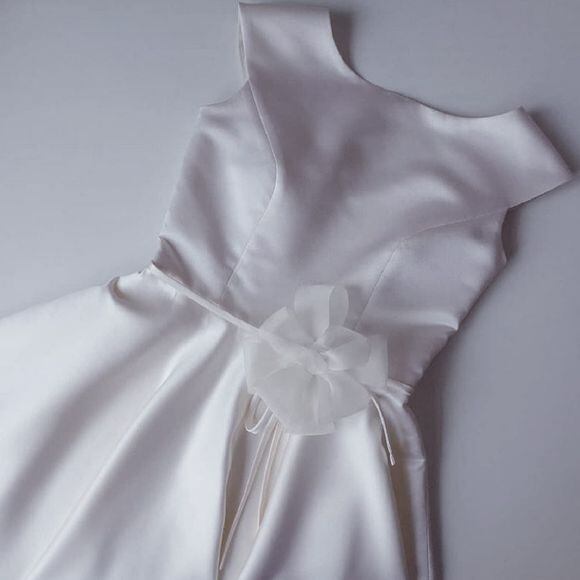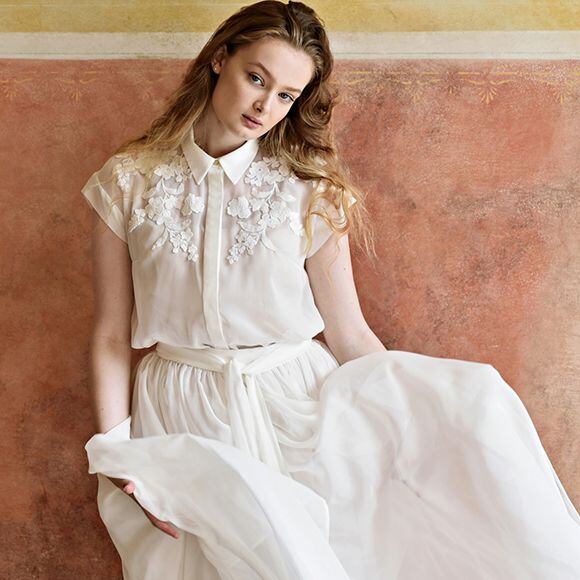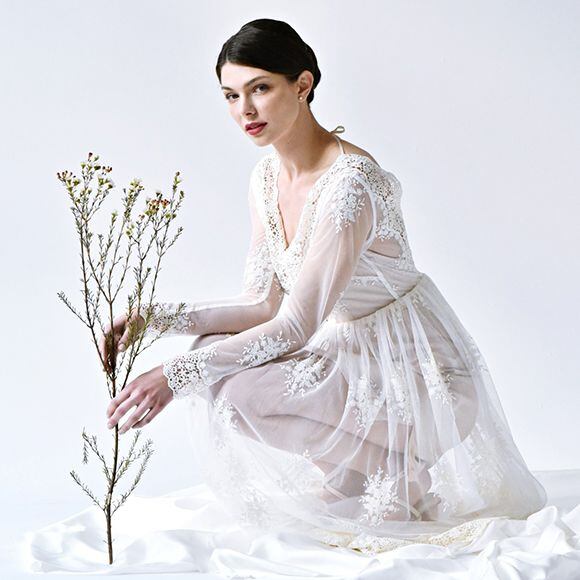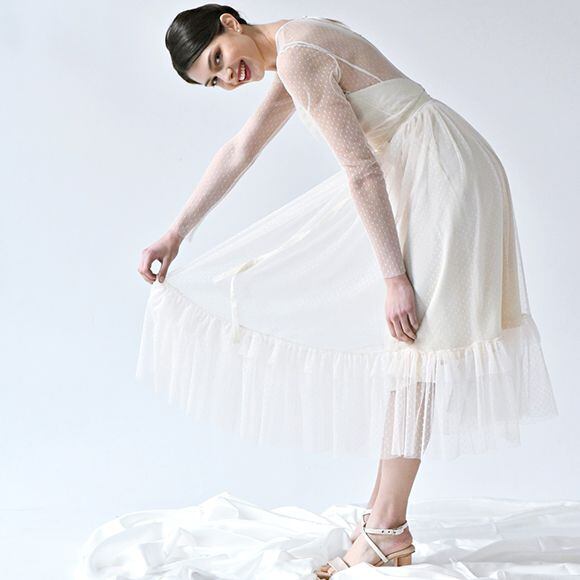
Your wedding will be a day to remember. It’s something you ought to enjoy and cherish for years to come – your own fairytale moment. A wedding is also a major celebration that calls for a great gown. We have yet to meet a bride who doesn’t want to be married in a gorgeous wedding dress.
Leaving the groom to make his own arrangements (a tuxedo rental, an off-the-rack purchase, or a visit to the tailor), let’s focus on the bride and her wedding dress. Choosing the right look is no easy task.
While a handful of brides may inherit a gown and some may order a dress online, this is one occasion where most women have their wedding dress made to order. There’s no better way to have a stunning, one-of-a-kind gown that fits to a T.
Choose only the best materials… nothing can beat a silk gown
Silk is simply beautiful and a bride in real silk is simply beautiful too. Inexpensive synthetic fabrics like polyester satin and polyester organza are mere imitations of natural silk originals and cannot replace the real thing. Not only does silk have a sheen and luxe appearance that can’t be faked, it’s comfortable too. Even the thickest silk fabrics breathe and feel comfortable against the skin – something that a bride will appreciate on her big day.
Avoid polyester and other synthetic fibers that don’t breathe at all costs. If you don’t opt for silk, choose a different breathable material. This is one time when you want to stay fresh. We’ll cover some alternatives to silk below.
What to consider when choosing bridal gown fabrics
There are three things to consider when choosing fabric for a wedding dress: Cost, cut, and style.
The question of cost doesn’t need much explanation. The price of your gown is made up of the cost of labor (e.g., the work of sewing) and the cost of materials, which is fabric (including lining, tulle for the underskirt, lace trim, etc.), ribbons, zippers, buttons, interfacing, and thread. The amount of fabric required will vary depending on the style of the gown, from a couple of yards for a modish short sheath to a dozen yards for the full treatment.
Consult your dressmaker to find out how much fabric various models require and find a gown that fits into your budget. Don’t forget to let your dressmaker know that you may be purchasing fabrics in non-standard widths – at Sartor we have widths from 75 cm (29½") to 180 cm (71").
Bridal fabric options
Different gowns call for different materials. To simplify things, let’s say that bridal gowns fall into roughly two categories: flowing and structured. Flowing gowns fall freely to the ground with no underskirt, often utilizing gathered and ruched effects. Structured gowns may have a full ballroom skirt with stiff crinolines or, at the opposite end of the spectrum, a tailored sheath skirt – in either case they call for sturdier fabrics that hold their shape well.
When choosing your fabric, you must know which of these gown types you’re working with – structured or flowing. The wrong choice of fabric, no matter how gorgeous it may be on its own, can ruin the dress.
Fabrics for structured styles
For A-line, ballroom, structured, or sheath skirts we recommend sturdier fabrics. All of the fabrics in our shop are rated for drape – look for those marked “stiff” or “slightly stiff.”



Silk duchesse satin
Duchesse satin is a very stiff, sturdy fabric often simply referred to as “bridal satin.” It has a smooth, satin face with a pearly sheen (a bit more matte than ordinary satin) and a very elegant look. This is a truly exclusive material that just begs to be shown off in a ballroom skirt or an intricate tailored cut (a corset bodice, a shape-hugging sheath, a bolero or jacket to match your gown).
We carry duchesse in 100% natural silk, a silk cotton blend, or a silk polyester blend. You may find synthetic duchesse elsewhere for less, but you would have to sacrifice comfort (synthetics don’t breathe) and beauty (nothing can compare to the special sheen of real silk).
Silk organza
Organza is a very crisp, sheer fabric that builds fabulous layers in bridal gowns. Use it for skirts, sleeves, bows, and other ornaments that will hold their shape well. This natural silk fabric breathes and has a nicer matte finish than synthetic organza you might find elsewhere.
Silk dupioni
Dupioni is a slightly stiff material, popular for its good looks and beautiful colors. Dupioni has a light, silky sheen that shows off pastels and brights to their best advantage. It is often woven as a shot silk – with the warp and weft threads in different shades – so the fabric appears to change colors depending on the angle from which you view it. This iridescent effect can be obvious (red with blue) or very subtle (white with golden white, pink with cream).
Dupioni forms sharp, paper-like folds that feature well in gathered, architectural pieces. Because of how it is woven, dupioni has an irregular, ribbed structure (the weft thread is thicker in some places) that may be very light or quite noticeable. Smoother dupioni is better suited for elegant dresses and rougher dupioni for romantic, boho gowns.
Silk taffeta
Taffeta is a smooth, slightly stiff material and very elegant. It is closely woven, very sturdy, and with a matte sheen. It has a papery quality, more so than dupioni, and is wonderful in full, rustling skirts as well as in structured bodices and sashes or bows. Like dupioni, taffeta is also woven in shot colors, in both bright and pale tones.
Brocade
Brocade is a stiff to slightly stiff fabric that looks wonderful in both full and slim skirts, bodices, jackets, and boleros. Its prominent patterns work best in smaller pieces such as short gowns, both full skirted and tailored, or combined with a solid fabric (a brocade bodice with a solid skirt, a brocade top with a solid suit, and so on).
We have brocade in white, champagne, and a range of pinks, creams, yellows, lavenders, and pale blues as well as bolder colors for less traditional wedding gowns or for accessorizing a traditional white gown. If you long for a really extraordinary dress, or if your wedding will have a historical theme, have a look at our authentic reproductions of historical brocades.
Linen
Linen may not be a common wedding dress fabric, but it can be just the thing for a simple, outdoor ceremony, adding a touch of rustic romance and back-to-nature minimalism.
A sturdy linen in a plain or twill weave is pretty in full, gathered skirts as well as tailored bodices. It’s not as stiff as silk duchesse or taffeta but can be given volume by adding an underskirt or simply starching it.
We have linen in pure white and ivory as well as natural tones and pale pastels.
Tulle
Tulle is a go-to fabric for bridal wear, appearing in veils, underskirts, and even full-on tulle wedding gowns.
For crinoline underskirts, we definitely recommend a stiffer tulle that can do some heavy lifting to support skirts made of duchesse or similar materials. Skirts made entirely of tulle employ multiple layers and the bottom layer should always be made of a stiffer tulle even if the upper layers use a softer vintage or veil tulle. This is the secret to a full skirt.
Flowing fabrics
Not every bride longs for a huge ballroom skirt. Flowing, draped bridal gowns are romantic and elegant. For flowing gowns, Greek goddess styles, and bias-cut dresses reminiscent of Hollywood’s golden age, choose a soft, supple fabric with a liquid drape. Look for fabrics in our shop with a drape of “slightly supple,” “supple,” and “very supple.”



Silk charmeuse and silk crêpe-backed satin
Charmeuse and satin are classic favorites. They are both wonderfully fluid, with a bright luster and liquid drape that delivers fabulous results in bias cuts.
Real silk satin (silk charmeuse) is miles above run-of-the-mill polyester satin. Real silk satin has an elegant sheen and, because it breathes, it’s very comfortable to wear, unlike its cheaper polyester cousin.
These are not suited for sewing straight-cut gathered skirts or classic princess gowns, which call for stiffer fabric with some volume. Silk satin really comes into its own in bias-cut gowns, ruched details, draped elements, and circle skirts. It goes well with chiffon and lace.
Silk crêpe marocain
Crêpe marocain is not unlike heavier satin but is decidedly less lustrous (it has a subtle pebbled structure) and falls in softer, fuller folds. It is a very luxurious, slightly heavy material. It works for the same gowns as silk satin, that is bias-cut glamour models, circle skirts, and romantic ruched dresses. It also works in a blouse to wear with a tailored suit.
Silk crêpe de Chine and crêpe georgette
Crêpe de Chine and crêpe georgette are light, matte fabrics that excel in simple, summer gowns. Imagine flowing circle skirts, wraps, bias cuts. In white and other light shades, both fabrics tend to be sheer, so they need a lining or should be worn with suitable nude lingerie.
Silk chiffon and silk georgette
Chiffon and silk georgette are fine, sheer fabrics that are lots of fun to layer. Chiffon is light and diaphanous. Its smooth surface combines well with satin and crêpe-backed satin. Georgette is a tad heavier. It has a matte sheen and a pebbled structure that means it works well with crêpe de Chine and other crêpe fabrics. Beyond the gown, both fabrics are great for scarves and veils too.
Silk jersey
Silk jersey has a wonderful drape and a bit of stretch. Unlike the fabrics above, it is a knit, not a weave. That’s where it gets its natural elasticity. Feather light and unbelievably comfortable, it looks good in form-hugging gowns with ruched effects. Because it is made of real, natural silk, it has a slight sheen that takes it a cut above ordinary cotton and rayon knits and helps it carry off dressy occasions such as a wedding.
Rayon fabrics
Other fabrics that work for flowing, draped bridal gowns include rayon, modal, and cupro. These are relatively modern materials, less expensive than natural silk, and with a number of positive qualities of their own.
Tencel satin, or Lyocell, is matte with a soft touch, almost like the skin of a peach. In contrast, rayon satin has a bit more luster. Both fabrics drape beautifully and are airy and comfortable. Cupro has a distinct, velvety, matte sheen and excels in unusual cuts (balloon dresses, ruched fashion-forward designs).
If you need a sheer, thin fabric that’s a touch less posh than silk chiffon for a linen or cotton gown, try a silk-cotton voile or a silk-modal blend. Both are nice in layered gowns and for bridal scarves and wraps.
Lace for bridal gowns
Lace wedding dresses are enjoying a moment in the spotlight and probably deserve a separate mention. Lace can be used for the entire dress, for just a part, or for trim. Try this versatile material for fancy, full-skirted gowns and for flowing dresses as well.



Corded lace
Most laces in our selection are corded laces with a decorative selvage that can be put to use in hems, sleeves, neckline, and bodice. Solitary elements and details may be cut out and appliquéd to the dress.
Chantilly lace
Match your lace to the style of the gown. Chantilly lace is flat and quite fine and works well with romantic dresses. It is also good as an chic, barely-there material to cover the arms and cleavage.
Alençon lace and beaded lace
Alençon lace and beaded lace have greater relief, with prominent patterns that are easy to cut around and appliqué to a gown (or to nude tulle to produce an effect where the lace seems to lie directly upon the skin).
Guipure lace
Guipure lace doesn’t have a tulle background at all, but is made up entirely of connected lace motifs that seem to be floating in space. It can be sewn onto any base fabric, either as a piece or as individual details. The motifs are easy to cut apart and work well as appliqué or for creating small accessories.
Backings for lace
There are many good backings for lace: Duchesse, dupioni, silk satin, taffeta, crêpe de Chine. Choose your fabric based on weight – a heavier lace needs a sturdier fabric (duchesse, taffeta, dupioni, heavy satin) while a lighter Chantilly or tulle lace complements lighter silk charmeuse or crêpe de Chine. Bolder, matte laces such as guipure are nice with linen or cotton. Fine fabrics such as chiffon, georgette, and softer tulles don’t work as well underneath lace, but can still be used to advantage alongside it (a lace bodice combined with chiffon in the skirt or a lace dress with a chiffon overlayer).
The many shades of white
When choosing your fabrics remember that white actually comes in a range of tones. There are cooler shades with a hint of blue and warmer shades with a hint of yellow. In our shop “pure white” is cool “ivory” neutral and “cream” a warm shade of white.

If you purchase fabrics and accessories in multiple shops, it’s a good idea to take swatches with you to compare shades. This holds true for colors like cream or champagne too because shades can vary widely.
If you combine multiple materials, stick to the same shade – pure white does not combine well with ivory or cream. If you want a satin dress with a layer of lace and you have opted for pure white, then the satin and the lace both have to be pure white, as do the veil and other accessories (shoes, clutch). Don’t forget the groom. If he will be wearing a white suit or shirt, then he should match your white too.
When combining white with another color, choose a pure white for cool tones like pale blue or lavender and an ivory for warm tones such as pink, cream, and beige. The rule extends to jewelry as well: Ivory and cream calls for gold, warm-toned gems, and cream-colored pearls, whereas pure white is what looks best with silver, white gold, and bright white pearls. By the way, you’ll find a nice selection of freshwater pearls in our shop. If you’re in the neighborhood, stop by an try them with your dress fabrics.
When deciding on a shade of white, consider your own color type too. Those with a cool complexion – Snow White types or porcelain blonds with fair complexions – will look good in pure white. Ivory and cream work better with warmer complexions. You’ll know when you place the fabric against your skin. If you can’t stop by our shop in Prague, we’ll be happy to send you free fabric samples.
The bottom line is don’t underestimate your choice… you don’t get married every day!
The proper choice of fabric for your wedding dress is essential. Look around at gowns of various cuts and styles and choose the one that suits you best, then select the right materials for the job. If you have a limited budget, consider whether your dress is really where you want to cut corners. After all, you’ll handle that inevitable case of nerves with far more aplomb when you’re decked out in beautiful, breathable, natural materials than you would sweating it out in polyester!
Still unsure what fabric to choose for your wedding dress?
We’re here to help
We’re here for you. If you’d like some help choosing your material, stop by our shop in Prague. We’ll be happy to walk you through the process. If you can’t make it to our brick-and-mortar shop, drop us a line at sartor@sartor.cz.



Comments(0)